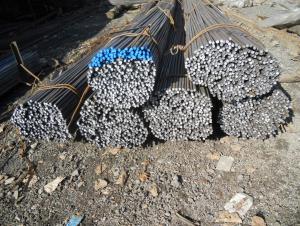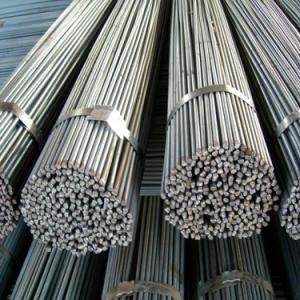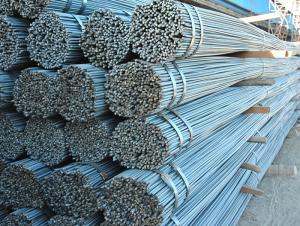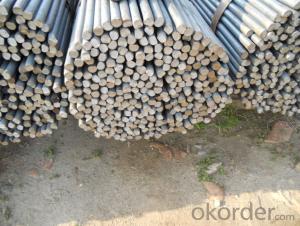Steel Round Bar-Standard GB
- Loading Port:
- China Main Port
- Payment Terms:
- TT OR LC
- Min Order Qty:
- -
- Supply Capability:
- -
OKorder Service Pledge
OKorder Financial Service
You Might Also Like
Specifications of Steel Round Bar:
1. Standard: GB
2. Grade: Q345
3. Invoicing on theoretical weight or actual weight as customer’s request
4. Shape: Round bar, solid bar of steel with circular section
5. Technique: Hot rolled
Size:
| Size (mm) | Section Area (cm2) | Mass (Kg/m) |
| 25 | 490.625 | 3.85 |
| 26 | 530.66 | 4.17 |
| 28 | 615.44 | 4.83 |
Packaging & Delivery of Steel Round Bar:
Packaging Detail: Standard seaworthy packing or as customer required; all goods are packed in bundle with steel strips and shipped by break bulk vessel or container
Delivery Detail: 45 days
Trade terms: FOB, CFR, CIF or as customer required
MOQ: 25 tons per specification; we can negotiate the quantity if the specification is normal or we have stock of one specification.
Weight: The price invoicing on theoretical weight basis or actual weight basis depends on customer’s request.
Shipment: The shipment of bulk break or container is depends on customer’s request.
Documents given: Full set (3/3) of original clean on board bill of lading; Original signed commercial invoice, in 3 originals and 3 copies; Original packing list in 3 originals and 3 copies; Policy of insurance; Certificate of origin and what the target market needs.
* If you would like to get our price, please inform us the size, standard/material and quantity. Thank you very much for your attention.
- Q:What is the difference between a solid and a hollow steel round bar?
- A cylindrical bar made entirely of solid steel material is called a solid steel round bar. It is completely filled and does not have any empty spaces inside. On the other hand, a hollow steel round bar is also cylindrical but has a hollow center, meaning there is empty space or a void within the bar. The primary distinction between a solid and a hollow steel round bar is their structural composition and the roles they fulfill. A solid steel round bar is typically used in applications where strength and durability are of utmost importance. It is commonly employed in construction, manufacturing, and engineering projects that require load-bearing capacity. Conversely, a hollow steel round bar is designed to be lighter in weight while still maintaining structural integrity. The hollow center allows for weight reduction while still providing sufficient strength for various applications. Hollow steel round bars are often utilized in industries such as aerospace, automotive, and marine, where reducing weight is crucial for enhanced fuel efficiency and overall performance. Furthermore, the empty space inside a hollow steel round bar also presents an opportunity for customization. It can be utilized to house other components, such as wires or piping, enabling a more streamlined and efficient design. This versatility makes hollow steel round bars suitable for various applications that necessitate both strength and weight reduction. In conclusion, the main difference between a solid and a hollow steel round bar lies in their structural composition and the roles they fulfill. Solid steel round bars are employed in applications that demand maximum strength and durability, while hollow steel round bars offer weight reduction and customization options, making them suitable for applications that prioritize lightweight design without compromising structural integrity.
- Q:Are steel round bars suitable for the production of bearings?
- No, steel round bars are not suitable for the production of bearings. Bearings require materials that have specific properties such as high hardness, wear resistance, and low friction coefficient. Steel round bars do not possess these characteristics in their natural state and would need additional processing and treatments to acquire the necessary properties for bearing production. Bearing materials are typically selected from alloys such as stainless steel, chrome steel, or ceramic materials that are specifically engineered to withstand the demanding conditions and provide optimal performance.
- Q:What is the difference between a polished and a hot rolled steel round bar?
- A polished steel round bar has undergone a process of polishing, which gives it a smooth and shiny surface finish. On the other hand, a hot rolled steel round bar is produced through a hot rolling process, resulting in a rougher and less refined surface texture.
- Q:What are the advantages of using sulfur-alloy steel round bars?
- There are several advantages of using sulfur-alloy steel round bars. Firstly, sulfur-alloy steel round bars offer improved machinability, making it easier to shape and cut the material into desired forms. Additionally, the sulfur content in the alloy enhances the overall strength and hardness of the steel, making it more durable and resistant to wear and tear. Moreover, sulfur-alloy steel round bars have excellent thermal conductivity, allowing for efficient heat transfer during various applications. Lastly, these bars are cost-effective as they offer a combination of desirable properties at a relatively lower price compared to other specialized alloys.
- Q:What are the different surface conditions for steel round bars?
- Steel round bars can have a variety of surface conditions, including hot rolled, cold drawn, peeled, polished, and turned. Each surface condition has its own unique properties and appearance, catering to different applications and requirements.
- Q:How are steel round bars tested for tensile strength?
- Steel round bars are tested for tensile strength using a method called a tensile test. This test measures the resistance of a material to a stretching force, and it is commonly used to determine the mechanical properties of metals. To perform a tensile test on a steel round bar, a sample is taken from the bar in the form of a cylinder or a rectangular shape. The sample is then prepared by removing any surface imperfections or irregularities. Next, the sample is inserted into a testing machine called a tensile testing machine. The machine consists of two grips, one at each end, which securely hold the sample. One grip is fixed while the other is movable. The testing machine applies an increasing force to the sample, causing it to stretch until it eventually breaks. As the force is applied, the machine measures the amount of force required to stretch the sample and records the elongation or deformation of the sample throughout the test. The test results are used to calculate various mechanical properties of the steel round bar, including its ultimate tensile strength. This is the maximum amount of stress the material can withstand before it breaks. Other properties such as yield strength, elastic modulus, and elongation at break can also be determined from the test. Tensile testing is a critical method for determining the quality and suitability of steel round bars for various applications. It helps ensure that the material meets the required specifications and can withstand the expected loads and stresses in its intended use.
- Q:What are the tolerance levels for steel round bars?
- Steel round bars have varying tolerance levels depending on the specific application and industry standards. To ensure precision in terms of diameter, straightness, and surface finish, steel round bars are typically produced with tight dimensional tolerances. Diameter tolerances specify the acceptable range of deviation from the nominal diameter of the round bar and are expressed as a plus or minus value, such as +/- 0.005 inches. The specific tolerance depends on the size, type of steel round bar, and application requirements. Straightness tolerances determine the allowable amount of deviation from a perfectly straight line along the length of the round bar. This tolerance is expressed as the maximum distance between the round bar and a straight edge placed along its length. For instance, a straightness tolerance of 0.030 inches per foot means that a one-foot section of the round bar can deviate up to 0.030 inches from a straight line. Surface finish tolerances specify the acceptable level of imperfections or irregularities on the surface of the round bar. This tolerance is often expressed using roughness average (Ra) or roughness peak (Rz) values. The specific tolerance depends on the desired surface finish and application requirements. It is worth noting that tolerance levels may also be subject to industry-specific standards established by organizations like the American Society for Testing and Materials (ASTM) or the International Organization for Standardization (ISO). These standards provide guidelines and specifications for various steel products, including round bars, to ensure consistent quality and performance. Ultimately, determining the tolerance levels for steel round bars involves considering the specific application requirements, industry standards, and the capabilities of the manufacturing process.
- Q:The two project is to use rebar or rebar?
- Of course, depends on what steel is used for components, such as the two structure of the structure column, and other minor parts, it does not matter. Suggest a slightly larger span of the floor, do not use round steel bar, or the use of thread steel bar, and then with anti crack steel.
- Q:How do you calculate the strength of a steel round bar?
- To calculate the strength of a steel round bar, several factors need to be considered. The primary factor is the material's yield strength, which represents the stress level at which the steel begins to deform permanently. This value is typically provided by the manufacturer or can be found in engineering handbooks. Next, the cross-sectional area of the round bar needs to be determined. This can be done by measuring the diameter of the bar and using it to calculate the area using the formula A = πr^2, where A is the cross-sectional area and r is the radius. Once the cross-sectional area is known, the ultimate tensile strength (UTS) can be calculated using the formula UTS = Yield Strength / Safety Factor. The safety factor is a numerical value that accounts for uncertainties and potential variations in the material's strength. It is typically specified by the design requirements or industry standards. Finally, the maximum load that the steel round bar can withstand before failure can be determined by multiplying the ultimate tensile strength by the cross-sectional area. This value represents the strength of the round bar and can be used to assess its suitability for a particular application. It is important to note that other factors such as the bar's length, shape, and any additional treatments or modifications can also affect its strength. Therefore, consulting with a structural engineer or referring to relevant design codes and standards is recommended to ensure accurate calculations and safe application of steel round bars.
- Q:Can steel round bars be used in the production of couplings?
- Indeed, couplings can be produced using steel round bars. These bars are widely employed across various industrial sectors owing to their robustness, endurance, and versatility. In terms of coupling manufacturing, steel round bars furnish the essential structural integrity and dependability demanded by such components. They can be manipulated, forged, or molded to conform to specific coupling designs and specifications. Additionally, steel round bars boast exceptional resistance against corrosion, a pivotal factor in ensuring the longevity and operational efficacy of couplings in diverse settings. All in all, steel round bars serve as an appropriate material selection for coupling production, guaranteeing the requisite strength and durability necessary for seamless and trustworthy coupling operations.
1. Manufacturer Overview |
|
|---|---|
| Location | |
| Year Established | |
| Annual Output Value | |
| Main Markets | |
| Company Certifications | |
2. Manufacturer Certificates |
|
|---|---|
| a) Certification Name | |
| Range | |
| Reference | |
| Validity Period | |
3. Manufacturer Capability |
|
|---|---|
| a)Trade Capacity | |
| Nearest Port | |
| Export Percentage | |
| No.of Employees in Trade Department | |
| Language Spoken: | |
| b)Factory Information | |
| Factory Size: | |
| No. of Production Lines | |
| Contract Manufacturing | |
| Product Price Range | |
Send your message to us
Steel Round Bar-Standard GB
- Loading Port:
- China Main Port
- Payment Terms:
- TT OR LC
- Min Order Qty:
- -
- Supply Capability:
- -
OKorder Service Pledge
OKorder Financial Service
Similar products
New products
Hot products
Related keywords






























